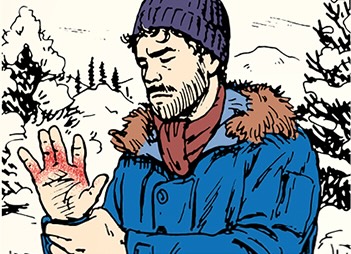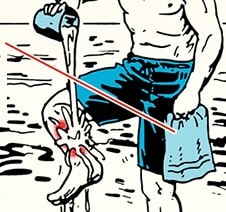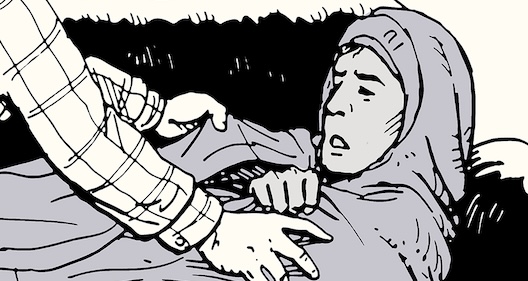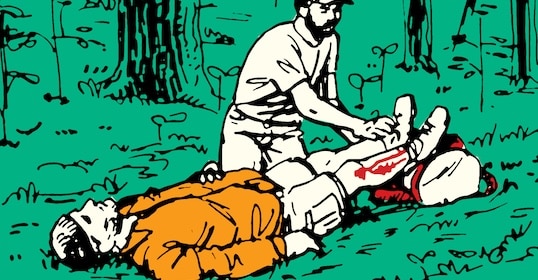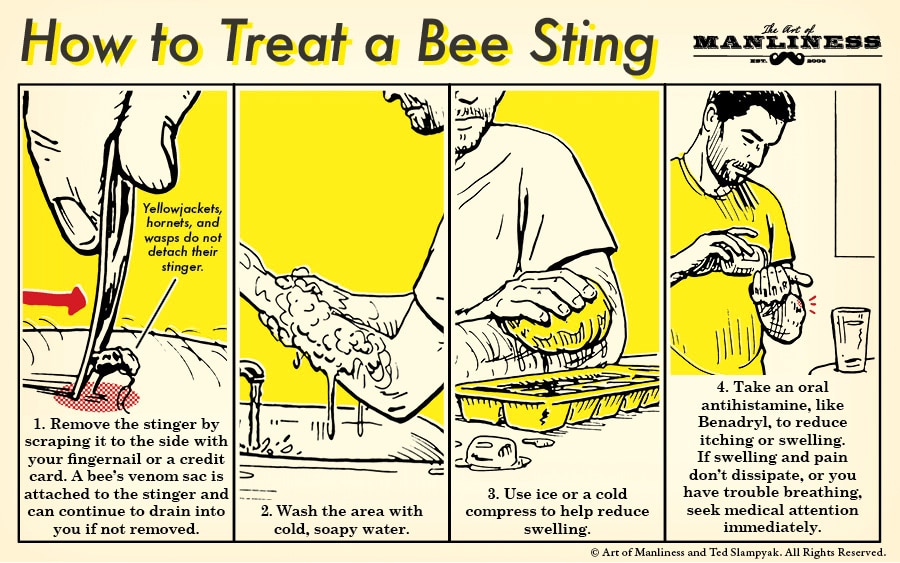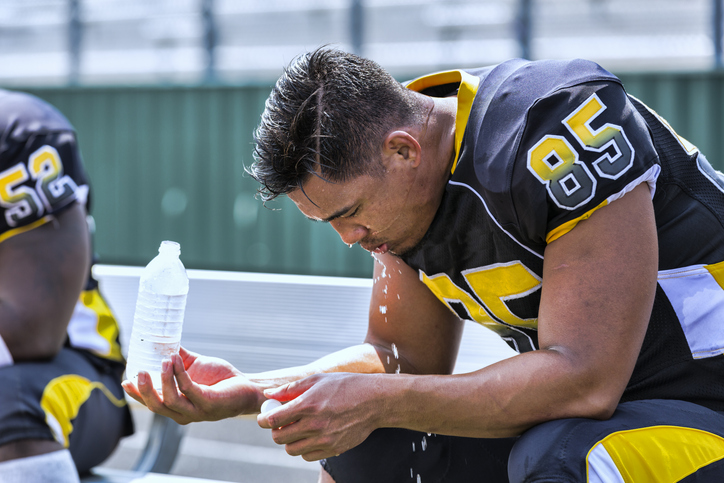
It’s been freaking hot around the world this summer. Here in Oklahoma we’ve had more than a dozen days in July alone with temperatures over 100 degrees.
The chances of suffering a heat-related illness like heat exhaustion and heat stroke go up during extreme heat. According to the CDC, between 2004 and 2018, an average of 702 people died annually from heat-related causes, and thousands more ended up in the hospital. Small children and adults over 65 are most susceptible to heat-related illness. However, it can hit anyone who works or exercises vigorously in the heat. In fact, heat stroke is one of the three most common killers of soldiers and athletes in training.
Below we share how to recognize heat exhaustion and heat stroke and what to do to treat both conditions.
How to Recognize & Treat Heat Exhaustion
Heat Exhaustion Symptoms
Heat exhaustion occurs when your body can no longer cool itself down through sweating due to a loss of water and electrolytes. Heat exhaustion needs to be treated as soon as you recognize it in yourself or others. Left untreated, it can develop into its more severe sibling: heat stroke.
Symptoms of heat exhaustion include:
- Heavy sweating
- Cold, pale, and clammy skin
- Fast, weak pulse
- Nausea or vomiting
- Muscle cramps
- Tiredness or weakness
- Dizziness
- Headache
- Brief fainting (passing out)
How to Treat Heat Exhaustion
The goal of treating heat exhaustion is to cool the sufferer down and restore their fluids.
- Move to a cool room. If you don’t have access to an air-conditioned room, at least move to a shady spot.
- Take a cold shower or bath. If that’s not possible, drape (do not tightly wrap — this will trap heat) cool, wet towels/cloths on the body. Turn a fan on these towels if you can.
- Remove extra clothing.
- Sip cool fluids, like water and Gatorade.
If heat exhaustion symptoms continue for an hour despite your treatment, seek professional medical assistance.
How to Recognize & Treat Heat Exhaustion
Heat Stroke Symptoms
Heat stroke is the most serious of heat-related illnesses. With heat stroke, the body has lost its ability to cool itself down, resulting in a dangerously high internal body temperature (above 104 degrees Fahrenheit). High internal body temperature is potentially life-threatening as it can cause seizures, organ failure, and rhabdomyolysis. Even if you recover from heat stroke, you can still suffer long-term damage to your heart, brain (creating cognitive deficiencies), kidneys (requiring lifelong dialysis or a transplant), and liver (also requiring a transplant). Heat stroke victims often die months after they’ve “recovered.”
To guide me on the intricacies of identifying and treating heat stroke, I talked to Sean Langan, a research assistant at the Korey Stringer Institute at the University of Connecticut. The Korey Stringer Institute specializes in research in preventing heat stroke deaths among athletes.
Heat stroke symptoms include:
- Central nervous system (CNS) dysfunction:
- Confusion
- Aggression/agitation
- Dizziness
- Fainting
- Seizures
- Very high body temperature (104 degrees F or higher)
- Red, hot, dry skin (no sweating). Sean notes that you rarely see dry skin in people with exertional heat stroke (caused by exercising or working in the heat). Those exerting themselves in the heat may still be sweaty, and you’ll need to be on the lookout for other symptoms, particularly CNS dysfunction.
- Throbbing headache
- Nausea/vomiting
- Rapid breathing
- Rapid pulse
According to Dr. Langan, the critical heat stroke symptom to be on the lookout for is CNS dysfunction:
You can have really fit people who have an internal body temperature of 104 degrees Fahrenheit at the end of a marathon who are fine. Their body is adapted to having that high of an internal temp so they don’t have any CNS dysfunction and they cool down quickly after they finish their race.
You can also have someone who has an internal body temperature of 103, but they’re experiencing CNS dysfunction. This person has heat stroke and needs to be treated.
If you see someone who’s been in the heat who’s showing signs of CNS dysfunction, your best bet is to start treating that person for heat stroke. To confirm, take their temperature with a rectal thermometer (it will give you the most accurate reading) to see if it’s around that 104-degree mark.
How to Treat Heat Stroke
If you suspect that you or someone else has heat stroke, immediately call 911. This is a life-threatening emergency.
After you’ve called 911 and while waiting for help, your goal is to cool the victim down as quickly as possible. Research shows that recovery from heat stroke is nearly 100% so long as the body is cooled down within 30 minutes of its onset. After that, serious, lasting, and potentially fatal complications will kick in. So time is truly of the essence.
- Move to a cool location.
- Remove excess clothing.
- Put the victim in an ice bath. This is the best treatment to pursue. If that’s not possible, douse the victim with cold water and place cold, wet cloths/towels all over their body.
- Pay special attention to cooling certain areas of the body. While you should cool the entire body down, research from Stanford scientist Craig Heller suggests that you shouldn’t overlook the palms of the hands and the bottoms of the feet. When we overheat, blood flow increases to these areas of the body, which Heller calls “natural mammalian radiators.” You can take advantage of this increased blood flow by placing cool rags on the palms of the victim’s hands and the bottoms of their feet. The cool rag will cool the blood, and the blood will return through the veins directly to the heart, helping to bring down the body’s temperature. Cold compresses in the groin and armpits will do the same thing.
- Once you’ve cooled the person down, provide fluids. Dr. Langan told me giving fluids to a heat stroke victim isn’t a top priority as it doesn’t do much to help cool the person down, which is your primary task. Once the victim is cooled down, offer fluids to rehydrate.
- Continue monitoring internal temperature until it is down to 102. According to Dr. Langan, that’s the safe zone.
Preventing Heat Exhaustion and Heat Stroke
An ounce of prevention is worth a pound of cure, and there are several things you can do to prevent heat exhaustion and heat stroke:
Drink plenty of water (and electrolytes). Duh! Your body cools itself by sweating. If you don’t have enough fluids in your body, you can’t sweat. If you know you will be outside in the heat, hydrate beforehand. While you’re out there, drink at least 8 ounces of water every 15 to 20 minutes.
Don’t skimp on the electrolytes either. Aim to ingest 500-700 milligrams of sodium for every hour you exercise. You can get this sodium from sports drinks or electrolyte pills. I like using a liquid electrolyte product, which allows me to add more or less to my water, depending on how much I’ve exercised/sweated.
Avoid being outside during the hottest parts of the day and when it’s humid. 3 to 5 p.m. is usually the hottest part of the day. If you can, stay inside during this window.
Also keep in mind that it’s harder for the body to cool itself the more humid it is.
Be fit. Fit people are not immune to heat stroke, but fitter people are generally better able to handle the heat. Start exercising. It’s the cure for almost everything.
Gradually acclimate to the heat. If you can’t avoid being outside in the heat due to scheduled work or sports, you can help your body adjust to it to reduce the likelihood of developing a heat illness.
Dr. Langan highlighted several adaptations your body makes as it acclimatizes to the heat. For example, you sweat more and start sweating at a lower body temp, your plasma volume increases, and your core body temp stays lower longer at a given workload.
Due to American football players dying from heat stroke in the late summer and early fall, several states have implemented mandatory preseason heat acclimation protocols for high school athletes. These states have seen a 55% reduction in heat illnesses since beginning these protocols.
The gist of the heat acclimation protocol is to gradually increase the length and intensity of activity done in the heat. Regular sauna use can also help speed the acclimation process along.
Dr. Langan told me that you can start to see heat adaptation in as little as 3-5 days, but if you really want to ensure you’re ready for hard work in high temps, two weeks is the ideal acclimation time.
Be smart, plan ahead, get adaptable, and you’ll be ready to face the heat.


